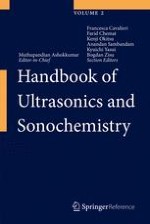2016 | OriginalPaper | Buchkapitel
Degradation of Organic Micropollutants by Hydrodynamic and/or Acoustic Cavitation
verfasst von : Patrick Braeutigam
Erschienen in: Handbook of Ultrasonics and Sonochemistry
Verlag: Springer Singapore
Aktivieren Sie unsere intelligente Suche, um passende Fachinhalte oder Patente zu finden.
Wählen Sie Textabschnitte aus um mit Künstlicher Intelligenz passenden Patente zu finden. powered by
Markieren Sie Textabschnitte, um KI-gestützt weitere passende Inhalte zu finden. powered by
